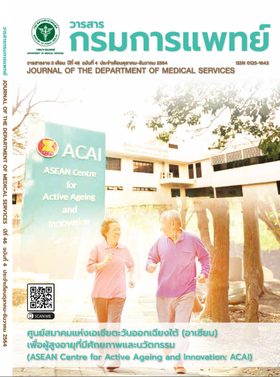Comparison of Surface Roughness Between Nanofilled and Microhybrid Composite Resin after Toothbrushing: a Systematic Review and Meta-analysis
Keywords:
Surface roughness, Tooth brushing, Nanofilled composite resin, Microhybrid composite resin, Meta-analysisAbstract
Background: Tooth Brushing is one of the most effective methods for removing dental plaque. However, tooth brushing has an effect on wear and surface roughness of restorative materials especially at cervical area and root surface which is directly affected area. Surface roughness of restorative material has direct effect on accumulation of bacteria and dental plaque. There is still controversy in comparation between surface roughness resistance of nanofilled and microhybrid composite resin after tooth brushing.Objective: Systematically review the literature and meta-analysis on a difference between surface roughness of nanofilled and microhybrid composite resin after toothbrushing.Method: The related studies were searched from electronic database PubMed and Google Scholar from 2000 until 2020. In total, 9 experimental studies met inclusion criteria and were included in meta-analysis. Risk of bias was assessed by ROBINS-I tool. Extraction data which were means and standard deviations of surface roughness before and after brushing.Result: Nanofilled composite resin has pooled SMD 3.250 (95% CI=2.234, 4.267; 8 studies, 114 samples, very low-certainty evidence), nanohybrid composite resin has pooled SMD 2.681 (95% CI=1.636, 3.727; 6 studies, 115 samples, very low-certainty evidence) and microhybrid composite resin has pooled SMD 2.951 (95% CI=2.027, 3.876; 9 studies, 119 samples, very low-certainty evidence) while data was high heterogeneity (respectively I2=82.4%, I2=87.4%, I2=78.8%). There was no high risk of bias in all assessment topics.Conclusion: Surface roughness of composite resins after brushing were increased which nanofilled composite resin was more than nanohybrid and microhybrid composite resin respectively. But because of high heterogeneity of data, few studies and possible risk of bias problems, the further higher quality researches and randomized controlled trials experimental research are still required to answer this question and for selection of restorative material in area which is directly affected by tooth brushing.
References
Ferracane JL. Resin composite--state of the art. Dent Mater 2011;27:29-38.
Bollen CM, Lambrechts P, Quirynen M. Comparison of surface roughness of oral hard materials to the threshold surface roughness for bacterial plaque retention: a review of the literature. Dent Mater 1997;13:258-69.
Jones CS, Billington RW, Pearson GJ. The in vivo perception of roughness of restorations. Br Dent J 2004;196:42-5; discussion 31.
Marghalani HY. Effect of filler particles on surface roughness of experimental composite series. J Appl Oral Sci 2010;18:59-67.
Wang L, Garcia FCP, Amarante de Araújo P, Franco EB, Mondelli RFL. Wear resistance of packable resin composites after simulated toothbrushing test. J Esthet Restor Dent 2004;16:303-14; discussion 314-5.
Garcia FC, Wang L, D’Alpino PH, Souza JB, Araújo PA, Mondelli RF. Evaluation of the roughness and mass loss of the flowable composites after simulated toothbrushing abrasion. Braz Oral Res 2004;18:156-61.
Moraes RR, Riberio Ddos S, Klumb MM, Brandt WC, CorrerSobrinho L, Bueno M. In vitro toothbrushing abrasion of dental resin composites: packable, microhybrid, nanohybrid and microfilled materials. Braz Oral Res 2008;22:112-8.
Wongprateepsiri N. The effect of whitening dentifrices on wear and surface roughness of resin composites. Chulalongkorn University: Chulalongkorn University; 2011.
Al Khuraif AA. An in vitro evaluation of wear and surface roughness of particulate filler composite resin after tooth brushing. Acta Odontol Scand 2014;72:977-83.
Kaizer MR, de Oliveira-Ogliari A, Cenci MS, Opdam NJ, Moraes RR. Do nanofill or submicron composites show improved smoothness and gloss? A systematic review of in vitro studies. Dent Mater 2014;30:e41-78.
Higgins JPT, Thomas J, Chandler J, Cumpston M, Li T, Page MJ, Welch VA (editors). Cochrane Handbook for Systematic Reviews of Interventions version 6.2 (updated February 2021). Cochrane; 2021.
Sterne JA, Hernán MA, Reeves BC, Savović J, Berkman ND, Viswanathan M, et al. ROBINS-I: a tool for assessing risk of bias in non-randomised studies of interventions. bmj. 2016;355.
Teixeira EC, Thompson JL, Piascik JR, Thompson JY. In vitro toothbrush-dentifrice abrasion of two restorative composites. J Esthet Restor Dent 2005;17:172-82.
Senawongse P, Pongprueksa P. Surface roughness of nanofill and nanohybrid resin composites after polishing and brushing. J Esthet Restor Dent 2007;19:265-73; discussion 74-5.
de Moraes RR, Goncalves Lde S, Lancellotti AC, Consani S, Correr-Sobrinho L, Sinhoreti MA. Nanohybrid resin composites: nanofiller loaded materials or traditional microhybrid resins? Oper Dent 2009;34:551-7.
Braga SRM, Tachibana TY, Garone-Netto N, Sobral MAP.
Abrasion resistance of different resin composites. J Health Sci Inst 2010;29:85-8.
Oliveira GU, Mondelli RF, Charantola Rodrigues M, Franco EB, Ishikiriama SK, Wang L. Impact of filler size and distribution on roughness and wear of composite resin after simulated toothbrushing. J Appl Oral Sci 2012:510-6.
Ishikiriama SK, De Oliveira GU, Maenosono RM, Wang L, Duarte MA, Mondelli RF. Wear and surface roughness of silorane composites after pH cycling and toothbrushing abrasion. Am J Dent 2014;27:195-8.
Kamonkhantikul K, Arksornnukit M, Takahashi H, Kanehira M, Finger WJ. Polishing and toothbrushing alters the surface roughness and gloss of composite resins. Dent Mater J 2014;33:599-606.
Ruivo MA, Pacheco RR, Sebold M, Giannini M. Surface roughness and filler particles characterization of resin-based composites. Microsc Res Tech 2019;82:1756-67.
Institute JB. New JBI levels of evidence. Adelaide: The Joanna Briggs Institute; 2014.
van der Weijden GA, Timmerman MF, Reijerse E, Snoek CM, van der Velden U. Toothbrushing force in relation to plaque removal. J Clin Periodontal 1996;23:724-9.
Goldstein GR, Lerner T. The effect of toothbrushing on a hybrid composite resin. J Prosth Dent 1991;66:498-500.
Yun JP, Chang SP, Xie TB, Zhang LL, Hu GY. A novel contact and non-contact hybrid profilometer. Precision Engineering 2009;33:202-8.
Downloads
Published
How to Cite
Issue
Section
License
Copyright (c) 2022 Department of Medical Services, Ministry of Public Health

This work is licensed under a Creative Commons Attribution-NonCommercial-NoDerivatives 4.0 International License.
บทความที่ได้รับการตีพิมพ์เป็นลิขสิทธิ์ของกรมการแพทย์ กระทรวงสาธารณสุข
ข้อความและข้อคิดเห็นต่างๆ เป็นของผู้เขียนบทความ ไม่ใช่ความเห็นของกองบรรณาธิการหรือของวารสารกรมการแพทย์



